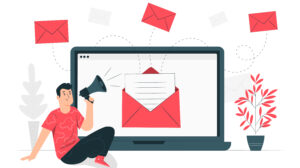Email marketing is a process of you sending commercial email messages to ’email subscribers,’ or people who have joined your mailing list and have given you their explicit permission to send them email. Email marketing is often used as a bridge between you and your customers to help keep the latter informed, increase sales, and create communities around your business – for example, by distributing newsletters.
Today, the same old traditional email marketing has shifted away from mass mailing practices that are one-size-fits-all in favor of permission, categorization, and personalization.
There are two types of email marketing campaigns that are used for very different purposes. These are promotional email marketing and informational email marketing.
Promotional Email Marketing
This type of email marketing campaign is used to advertise a special deal, a new product or service launch, introduction of ebooks, or an invite to a seminar/webinar or conference, among other things. A campaign might be made up of three to ten emails that are delivered over several days or weeks.
An unambiguous call-to-action or CTA appears in such promotional communications. The CTA denotes the precise action you would like the person reading to perform, such as visiting a website or purchasing your offering.
This form of business email is delivered as needed by your company.
Informational Email Marketing
Informational email marketing is divided into two distinct types.
Newsletters: A newsletter is used to provide ‘news’ about your company such as new benchmarks achieved, new offering features, or to showcase a product demo. Newsletters, sent regularly can be be weekly, biweekly, or monthly and help you establish a continuous relationship with your readers.
Newsletters, however, don’t need to be about ‘breaking news’ as such. Concentrate on the message component. Assume that you’re producing a personalized message to each of your readers about a topic that engages and interests them while serving them some kind of value.
Put another way, a newsletter is a great opportunity to give insights, views, suggestions, or whatever your readership finds most valuable.
Announcements: Email is one of the most reliable and best methods to keep consumers informed about corporate news, releases and launches, service updates, and so on.
Emails provide the essential components for sending significant communications as a medium. This might explain the reason why, during the COVID-19 pandemic, many brands preferred to deliver crisis messaging via email.
How does email marketing work?
Email marketing is simply a type of digital marketing practice that involves sending electronic mail or email communications to the intended audience. The emails are primarily commercial, but they may also be used to teach and inform the receiver on a variety of issues.
Email marketing, to put it simply, is the practice of leveraging email as a marketing and sales channel. You’ll need a large email list of individuals who signed up voluntarily to receive your communications for your email marketing to be successful.
Purchasing email lists, especially when they have emails from individuals who are linked to your industry, are automatically excluded from this work process.
Is email marketing still relevant?
Everybody enjoyed emails when access to the internet became readily available for the first time. Whenever something fresh and intriguing arrived in our digital mailbox, we were ecstatic. However, in today’s world, recipients are skeptical of unexpected communications and selective as to who they permit into their mailbox.
As a result, many entrepreneurs find themselves asking a very common question; “Are email marketing strategies still an efficient and viable strategy for businesses?”
The answer to this question is, YES!
When done right, email marketing can be very effective for some very distinct reasons. Right now, the world of corporate runs on emails. Every person that has access to basic internet has an email address. Thus, email marketing can reach a massive audience easily.
In addition to that, it is also very well known that email marketing is one of the cheapest options available for digital marketing out there and thus, is ideal for businesses of any size with any amount of funding. You can just do it on your own if you have a small budget or hire a digital agency so that you can focus on other business operations.
Email marketing campaigns, however, can be pretty ineffective if it not done in the right way.
Certain bad practices can completely ruin your email marketing campaign and make things go haywire. Here are some common mistakes that digital marketers make that stop emails from getting converted into actual business dealings:
Top 9 Reasons Why Your Emails May Not be Converting
1. Lack of Data Analysis
Email marketing and process automation systems include a wealth of analytical tools and statistics to help you analyze and assess the performance of your commercial and promotional emails. Thus, if you aren’t keeping a track of everything, you’re probably missing out on important information as to why your method is failing.
Make A/B testing and statistical analysis a frequent and regular component of your email marketing strategy, if you haven’t previously. By making such arrangements, you will be able to observe which things work and which don’t work at all. It will help you make more efficient and informed judgments ahead.
2. Boring copy
It’s possible that your business emails aren’t converting because they aren’t particularly attractive to your readers.
Day in and out, most people receive a large number of emails that are related to different aspects of their lives. As a result, to manage their overflowing inboxes, people prioritize what emails they want to interact with and what they want to ignore to avoid overwhelming themselves, which typically implies that perhaps the emails and newsletters that get clicked upon probably have more appealing copy than what you are currently using.
You just have a few seconds to captivate your readers, so ensure your material and text are up to the task. Mix it up by using photographs, movies, and other attention-grabbing elements in addition to text content.
3. Low-quality Content
A very common blunder made by digital marketers is using material that isn’t worth a dime. It is a pretty serious problem if the material you distribute isn’t compelling. Readers will lose interest at some point and opt out of your business mailing list or blog.
You should also never send emails riddled with spelling errors and grammatical faults. It is important to realize that such practice will destroy your chances of making a transaction.
By distributing bad content, you are indicating to your readers and prospective customers that you have a low-quality control system because your business doesn’t even bother to check a badly worded email before sending it out. And if that’s the case, how can people trust the goods or services you’re selling?
Before clicking the submit button, be certain that your content is top tier, high quality, and engaging. Similarly, you should double-check the content on your homepage. Is the reader of your email directed to your official site? If that’s the case, make sure the landing page is attention-grabbing. You don’t want to send prospective consumers fleeing into the hands of your competition.
4. Unclear CTA
Conversions aren’t frequently made by chance. You shouldn’t be shocked at results if you don’t incorporate a clear, forceful, and unambiguous CTA with well-placed contact options.
You must make sure that your prospective customers understand exactly what you require them to do when your emails reach them.
If you desire the recipient to read a recent blog article, join a webinar that you are hosting, or make a purchase, you must make be clear and present the actions you want them to take unambiguously. If you fail to communicate clearly through the CTA, you’re squandering engagement by failing to put it to good use.
5. Emails Lacking Value
Successful business emails all seem to have 1 common factor: they add some value to their receivers’ life.
Not everybody is as enthused about the same topics as you, and they aren’t interested in wasting their time on emails and letters that don’t have a benefit.
And, if you too are missing the whole point of providing value to your subscribers, they will be less likely to view your business emails.
Provide your readers with something valuable in exchange for their time, like a voucher, a free download, or early access to a newly launched product. You’ll see an increase in conversions right away, and also interest which will carry over into future marketing campaigns.
6. Badly Segmented Lists
Bulk emails should be avoided at all costs. Delivering the same information to your whole mailing list is the ultimate recipe for an email marketing disaster since it falls short of contemporary customer needs for customization. Not all information is relevant to all customers.
You must divide your mailing lists into clear segments, and you must do it appropriately when it comes to sending commercial emails. Most firms do this by segmenting their customer contacts into groups based on their position in the funnel, then sending tailored material to every group according to their tastes, preferences, inquiries, and problem areas.
7. Click Baiting
Have you heard of the term “click-baiting”? The term refers to generating material with the sole intention of capturing reader attention and enticing them to engage with your desired links to make money from advertisers.
Clickbait may come in a variety of formats, including email. It is not a good idea to rely on spectacular headlines or a provocative image to generate visitors to your website. People are growing smarter and better at recognizing clickbait-style stuff these days, and they won’t hesitate to remove you from their personal social media pages.
There’s a distinction between writing headlines that convert to something more valuable and exploiting a reader’s intrigue intentionally for gain.
8. Content Stuffing
“Content is king,” is a very popular saying in the marketing and content sector and is true to its meaning. But, it is only true when you are writing a long-read blog article. Not all content is suitable for all kinds of communication media. The wrong content in an email can have disastrous consequences.
Acknowledge that a substantial percentage of your users will read your emails and newsletters on a mobile device. As a result, cramming your mails with a lot of information, photographs, wacky graphics, and a lot of unnecessary design elements will only irritate readers while ruining their concentration, not to mention the increased amount of time it will take for them to download the email.
Keep your content short and sweet, with only one call to action or CTA. Don’t bombard your readers with too much content and sensory experiences in an attempt to accomplish many objectives in a single email.
9. Email Repetitions
Busyness or general laziness in marketing strategies results in some businesses distributing emails that have been sent to their audience many times. If your company does this, it will suffer a poor response.
Most importantly, the recipient will quickly recognize the emails as spam emails. In addition, if the email was ineffective the first time you sent it, it will most likely be ineffective again. Do your homework and deliver freshly crafted emails each time if you’re seeking to build your business.
Conclusion
Email is one of the most low-cost ways to reach out to potential consumers, but poor campaigns convey the idea that a company merely intends to steal resources and leave nothing in exchange. Effective email marketing campaigns prioritize client demands and provide practical solutions to common issues without overpromising. By avoiding the discussed mistakes, digital marketers can address their demographic significantly more successfully; even surpassing traditional radio and TV advertisements.





